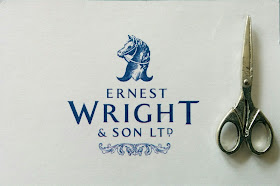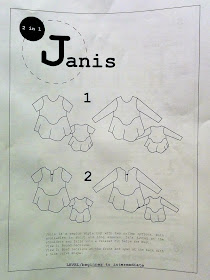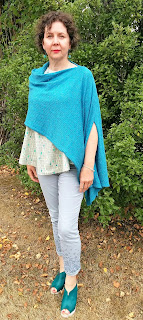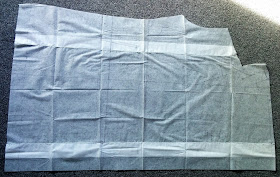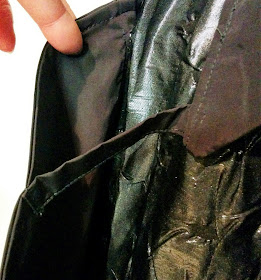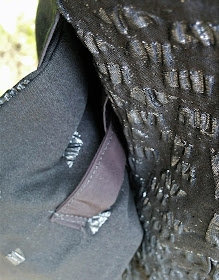I love this outfit but think its time is limited as the colours in the trousers are starting to fade, although they look fine in these photos. So I took some selfies to celebrate the Style Arc Maris top sewn in a Milly silk fabric from Elliott Berman Textiles paired with my Andrea Moore foxy skinny pants and Vic Matie navy shoes.
Sorry about the toilet ambience but the mirror in the bathroom at work is good for headless selfies. Now how do I do a selfie of the back?
Saturday, 25 March 2017
Saturday, 18 March 2017
A New Pair of Scissors
I was recently given a very special pair of Ernest Wright and Sons scissors. They are not perhaps what you were expecting being a small pewter brooch from a traditional scissor manufacturer in my old home town of Sheffield, England. These are a very special pair of scissors because as well as being a gift from a friend they are an example of the modern phenomena of crowd funding.
A few months ago Ernest Wright ran a Kickstarter project to start production again of their handmade Kutrite kitchen scissors first produced in the 1960's. This seemed like a good opportunity to support an old industry with dying skills. Many other people agreed with me as the Kickstarter project raised £248,419 from 3,684 people, way above its original target. After making my pledge and supporting this worthwhile cause I spread the word - letting all of my 22 Facebook friends know!
Cheryll joined the cause to keep the traditional skills and industry alive. When Cheryll received her traditional Turton kitchen scissors she shared her bounty with me, giving me one of her pewter scissor pins, which I wear with pride. Just love my scissors, thank-you.
I have to wait a bit longer for my scissors as the Kutrite scissors are being started from scratch with the dies being made and the blanks forged before being handcrafted into my new kitchen scissors.
If you too would like to support a small family owned business that has been making the finest hand-made scissors and shears since 1902, in a once great manufacturing city famous for its stainless steel, they make some great sewing and embroidery scissors.
The Ernest Wright and Son website contains two fascinating and informative videos about the art of scissor making. One is by the late Shaun Bloodworth, also a Sheffield local and the other is a BBC interview.
A few months ago Ernest Wright ran a Kickstarter project to start production again of their handmade Kutrite kitchen scissors first produced in the 1960's. This seemed like a good opportunity to support an old industry with dying skills. Many other people agreed with me as the Kickstarter project raised £248,419 from 3,684 people, way above its original target. After making my pledge and supporting this worthwhile cause I spread the word - letting all of my 22 Facebook friends know!
Cheryll joined the cause to keep the traditional skills and industry alive. When Cheryll received her traditional Turton kitchen scissors she shared her bounty with me, giving me one of her pewter scissor pins, which I wear with pride. Just love my scissors, thank-you.
I have to wait a bit longer for my scissors as the Kutrite scissors are being started from scratch with the dies being made and the blanks forged before being handcrafted into my new kitchen scissors.
If you too would like to support a small family owned business that has been making the finest hand-made scissors and shears since 1902, in a once great manufacturing city famous for its stainless steel, they make some great sewing and embroidery scissors.
The Ernest Wright and Son website contains two fascinating and informative videos about the art of scissor making. One is by the late Shaun Bloodworth, also a Sheffield local and the other is a BBC interview.
Saturday, 11 March 2017
Ready to Sew Janis Sand Bar Top
This is the Janis top view one by Ready to Sew a relatively new French company. One of the myriad sewing blogs I read (sorry can't remember which one) had made a Janis top and I am always looking for woven fabric tops with a different style so thought I would give it a go. I am quite tempted by the Jacob design too but wanted to actually make a Ready to Sew pattern before I purchased any more.
The finished garment
The fabric
The fabric is an Art Gallery Fabrics (AGF) knit called Sand Bar Lagoon from Stonemountain and Daughter purchased in September 2016. It is a gorgeous cotton knit with 5% spandex, very soft with great drape and a good weight (260gsm). Definitely not a flimsy see through knit.
The pattern
Janis is described as a peplum style top with two collar options, both available in short and long sleeves. It's fitted at the shoulders and falls into a relaxed fit below the bust. I made view one which has a round neckline.
This is a PDF pattern which needs to be printed and taped together (all 33 A4 pages). Not my favourite way of passing the time but I am adjusting to the pattern assembly task for the convenience of a new pattern instantaneously - no waiting for the post.
This PDF is layered so you can choose to print all sizes or in my case the three sizes you think you might be. The benefit of this is that you don't have lots of confusing lines on the paper so less chance of accidentally cutting the wrong size.
The pattern alterations
I printed three sizes of the pattern (36, 40 and 44). To determine which size would be best I compared the pattern pieces to my TNT woven top. Whilst I was using a knit I only wanted it for the drape not the negative ease.
For the back I cut out the size 36, with the length of the 44. For the front I cut out the size 36 at the shoulder tapering out to the 44 at the side seam. For the peplum piece I cut out the size 40 which worked well with the two different sizes used for the front and back. I didn't use the sleeve provided instead using my favourite knit sleeve (from Silhouette Patterns Sweater Set #195) which has already been altered for a forward shoulder.
The front neck edge was lowered slightly by about ¼". The width of the shoulder seam was reduced by ½". A forward shoulder adjustment was made, raising the back shoulder seam ½" at the armhole edge tapering to nothing at the neck edge and lowering the front shoulder seam by the same ½". The armhole was then redrawn using my favourite knit armhole to account for the changes. Whilst I used my favourite knit armhole and corresponding sleeve the armholes on this top are very close to my knit armhole depth.
If I ever use the facing pieces I will need to redraw the front facing to take into account the changes made to the neck edge.
There are a number of changes I would make to this top if it is ever sewn in a woven fabric. One of which is the back armhole shape, which I would lower 1¼", because in my opinion the original armhole in a woven would seriously limit your range of arm movement. The front armhole for me would be fine but bear in mind that I do a forward shoulder adjustment which removes ½" at the front and adds it to the back. The front piece would also need an FBA, which would create a bust dart. It may also be useful to add waist darts at both front and back to limit the poufiness, which would then mean a reduction in the width of the peplum equivalent to one waist dart.
The sewing
Nothing really to say about the sewing. I can't comment on the standard of the pattern instructions because I didn't use them. This is a really easy sew on the overlocker which went together quickly. The hems and neck edge were turned under 3/8" and sewn with a single row of straight stitch on the sewing machine.
The styling
Janis top worn with NYDJ Nina ankle jeans in colourway bluegrass with Untouched World Blot merino wrap in colourway inspire. The turquoise wedge sandals are by Pretty Things Inside.
Same outfit with a different wrap this one is Untouched World Merino Mink two tone poncho in colourway mist. Merino Mink is a blend of Merino wool, brushtail Possum fibre, silk and angora. It is divine to wear - light but snuggly warm.
Whilst this pattern is suitable for a woven fabric I wanted to try it with the drape of a knit fabric first. I loved the style but was a bit worried it would hang on me in an unflattering way.
My beloved took many photos of me in this top but I really am a hopeless model. Hardly any were usable because I had my eyes closed. In this one I might look like a little tin soldier in need of the loo but at least I have my eyes open.
The fabric
The fabric is an Art Gallery Fabrics (AGF) knit called Sand Bar Lagoon from Stonemountain and Daughter purchased in September 2016. It is a gorgeous cotton knit with 5% spandex, very soft with great drape and a good weight (260gsm). Definitely not a flimsy see through knit.
The pattern
Janis is described as a peplum style top with two collar options, both available in short and long sleeves. It's fitted at the shoulders and falls into a relaxed fit below the bust. I made view one which has a round neckline.
This is a PDF pattern which needs to be printed and taped together (all 33 A4 pages). Not my favourite way of passing the time but I am adjusting to the pattern assembly task for the convenience of a new pattern instantaneously - no waiting for the post.
This PDF is layered so you can choose to print all sizes or in my case the three sizes you think you might be. The benefit of this is that you don't have lots of confusing lines on the paper so less chance of accidentally cutting the wrong size.
The pattern alterations
I printed three sizes of the pattern (36, 40 and 44). To determine which size would be best I compared the pattern pieces to my TNT woven top. Whilst I was using a knit I only wanted it for the drape not the negative ease.
For the back I cut out the size 36, with the length of the 44. For the front I cut out the size 36 at the shoulder tapering out to the 44 at the side seam. For the peplum piece I cut out the size 40 which worked well with the two different sizes used for the front and back. I didn't use the sleeve provided instead using my favourite knit sleeve (from Silhouette Patterns Sweater Set #195) which has already been altered for a forward shoulder.
The front neck edge was lowered slightly by about ¼". The width of the shoulder seam was reduced by ½". A forward shoulder adjustment was made, raising the back shoulder seam ½" at the armhole edge tapering to nothing at the neck edge and lowering the front shoulder seam by the same ½". The armhole was then redrawn using my favourite knit armhole to account for the changes. Whilst I used my favourite knit armhole and corresponding sleeve the armholes on this top are very close to my knit armhole depth.
If I ever use the facing pieces I will need to redraw the front facing to take into account the changes made to the neck edge.
There are a number of changes I would make to this top if it is ever sewn in a woven fabric. One of which is the back armhole shape, which I would lower 1¼", because in my opinion the original armhole in a woven would seriously limit your range of arm movement. The front armhole for me would be fine but bear in mind that I do a forward shoulder adjustment which removes ½" at the front and adds it to the back. The front piece would also need an FBA, which would create a bust dart. It may also be useful to add waist darts at both front and back to limit the poufiness, which would then mean a reduction in the width of the peplum equivalent to one waist dart.
The sewing
Nothing really to say about the sewing. I can't comment on the standard of the pattern instructions because I didn't use them. This is a really easy sew on the overlocker which went together quickly. The hems and neck edge were turned under 3/8" and sewn with a single row of straight stitch on the sewing machine.
The styling
Janis top worn with NYDJ Nina ankle jeans in colourway bluegrass with Untouched World Blot merino wrap in colourway inspire. The turquoise wedge sandals are by Pretty Things Inside.
Same outfit with a different wrap this one is Untouched World Merino Mink two tone poncho in colourway mist. Merino Mink is a blend of Merino wool, brushtail Possum fibre, silk and angora. It is divine to wear - light but snuggly warm.
Saturday, 4 March 2017
Vogue 1836 Issey Miyake Gorgeous Raincoat
I have been a long time fan of Issey Miyake patterns and have collected many over the years but they seem to be something to look at and are not often made. There have been many pattern cleansing sessions during my sewing career but the Issey Miyake patterns always survive waiting for their moment. So 20 years after it was initially published Vogue 1836 saw the light of day destined to become a Gorgeous raincoat.
The finished garment
This raincoat took five months to finish. I started it in October 2016 originally intending to take it with me to America but I ran out of time to hem it, make the buttonholes and sew on the buttons. There were also some bits that weren't quite as I wanted, which I would have lived with if it had been finished for the trip. Instead it sat unfinished in the pile on my sewing table. In February 2017 it was unearthed and finished. Now we just need some rain - a bit late for the trees which have already shed their leaves but green grass would be nice.
The fabric
Vogue 1836 from 1996 just seemed ideal for this raincoat fabric from Gorgeous Fabrics purchased a few years ago. The only small fly in the ointment is that the pattern requires 5 yards of fabric and I had 3. Now generally Vogue patterns are generous in their fabric allowances but there was no way to eke this garment out of 3 yards. Although I probably came close with the ease I removed!! So off to The Fabric Store to find a complementary fabric to use with it. In the end I only needed this fabric for the sleeves and the extra bits inside like the pockets, back stay and front button flange.
The pattern
This pattern is advanced, described as an oversized, slightly flared, unlined coat, above mid- knee, has front extending into standing back collar with concealed buttonholes, slightly forward shoulder seams, front shoulder pleats, front button flange, welt pockets, button/tab, back stay, mock bands, stitched hems, longer than regular length sleeves with fold-back cuffs, belt carriers with button/loop.
Oversized is a slight understatement the size small is nearly twice the circumference of my actual body measurements, although some of that is the collar.
One of the questions Pattern Review asks is does this look like the pattern envelope and the answer would have to be sort of. It has the bones of the pattern envelope look just with less ease and a much shorter belt.
The pattern alterations
The fact that I am happy with this garment can be attributed to the teachings of Peggy Sagers of Silhouette Patterns. What I learnt from Peggy after watching her free (and purchased) videos was a real epiphany for my sewing, increasing the frequency of satisfaction with the finished garment hugely.
I no longer make up a garment based on my supposed size on the pattern envelope but by the actual garment measurements that are usually printed on the pattern tissue of Vogue patterns, taking into consideration the amount of ease I prefer. Who knew you could have an ease preference. Well of course you do - when you buy ready-to-wear and the garment drowns you a smaller size is tried on or you leave the garment in the shop. I always loved the look on the pattern envelope but hated my oversized sewn garments without making the connection as to why. I also make garments using my under bust measurement then make an FBA as this fits my shoulders (and frame) much better.
For this pattern the finished garment measurements for the size small were: bust 76"; hip 72"; back length 36¾". I removed 22" of garment ease and added 2¼" to the length. Four inches of ease were removed at each side, front and back straight down from the shoulder seam (total 16") and a further 3" were removed from the collar piece (total 6"). I traced my pattern onto lightweight sew-in interfacing and folded out the unwanted ease as can be seen in the photo. A garment with nearly 30" of ease and with such dropped shoulders I know from experience would drown me and create the look of a child playing dress-up in mum's clothes.
As the pattern had so much ease there was no need for an FBA. The pattern also had a slightly forward shoulder seam so I didn't need to make that adjustment either.
There was a further inadvertent pattern alteration due to a fixation about having the fabric "stripe" run vertically which caused challenges when cutting out. After spending some time puzzling how I could place the body garment pieces on the fabric cross grain so that the "stripes" were vertical the perfect solution suddenly appeared. Actually by this stage I had forgotten about placing the front body pattern piece on the fold at the collar centre back. Forgetting this key instruction led to removing 1¼" from the collar at centre back (the unplanned but now required seam allowance).
I used the longest length for the belt but it is still much shorter than the one in the picture on the pattern envelope.
The sewing
I actually used the pattern instructions to make this garment. Sometimes they caused puzzlement which I worked through and other times I did my own thing as I couldn't solve the puzzle.
There are many pattern markings of different shapes and sizes. I used tailor tacks to mark them on the garment but used the same colour thread and had to keep referring to the front pattern piece as I sewed to identify which tailors tack represented the different markings.
The coat is unlined so I wanted the inside to look as neat as the outside. Luckily the pattern uses faux flat felled seams (sew the seam wrong sides together with a 5/8" seam allowance, trim one side of the seam allowance to ¼" and fold the larger seam allowance around the smaller one and edge stitch).
The single welt pockets caused confusion, much searching on the internet, through books and watching of YouTube videos. Not sure why they caused so much head scratching. Maybe I am too used to the Peggy Sagers method. Issey uses a method closer to that illustrated by Oliver and S. Eventually enlightenment dawned and I was able to follow the instructions to create a neat welt pocket, including enclosed edges created by a french seam on the pocket bag. The other clever thing is the pocket support which attaches to the front flange and the pocket. This keeps the pocket bag in place and stops it sagging.
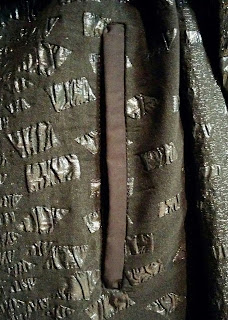
In October I followed the pattern and had gathers at the neck seam at centre back. This was one of the not quite right parts of the garment which when I came back to the coat in February I decided to fix. The gathers were sufficiently bulky to stick out and give me a strange lump on the back of my neck under the collar. Out came that essential sewing tool the quick unpick. Undoing this neck seam had the added advantage of removing an oopsie pleat in the fabric at the shoulder where the neck and shoulder seam meet. A 3¼" box pleat was created and the neck seam re-sewn. Originally the box pleat was only stitched down 3" from the neck edge but looking at the extra fabric across the back I decided to stitch the box pleat down to the waist. This effectively removed a further 6½" of ease and solved the large tucks of fabric near the armhole caused by excess fabric across the back width, another bit I didn't like about the October version of the garment.
The back stay lays much flatter with the box pleat too.
At the collar centre back there is a button and loop so that the collar can be folded in half. The collar folds over the button down to the neck edge.
The belt has a button loop to secure it to the belt carriers but I didn't like the fact that the button loop is on the public side of the belt. So when I came back to the coat in February I made a second set of smaller belt carriers at the side seams for the button loop to use and be hidden under the belt. In the end the button loop didn't have a button I used a 6mm press stud fastener instead. I also added a belt carrier at centre back secured into the bottom of the box pleat.
The finished garment
This raincoat took five months to finish. I started it in October 2016 originally intending to take it with me to America but I ran out of time to hem it, make the buttonholes and sew on the buttons. There were also some bits that weren't quite as I wanted, which I would have lived with if it had been finished for the trip. Instead it sat unfinished in the pile on my sewing table. In February 2017 it was unearthed and finished. Now we just need some rain - a bit late for the trees which have already shed their leaves but green grass would be nice.
The fabric
Vogue 1836 from 1996 just seemed ideal for this raincoat fabric from Gorgeous Fabrics purchased a few years ago. The only small fly in the ointment is that the pattern requires 5 yards of fabric and I had 3. Now generally Vogue patterns are generous in their fabric allowances but there was no way to eke this garment out of 3 yards. Although I probably came close with the ease I removed!! So off to The Fabric Store to find a complementary fabric to use with it. In the end I only needed this fabric for the sleeves and the extra bits inside like the pockets, back stay and front button flange.
 |
| Gorgeous fabric right side |
 |
| Gorgeous fabric wrong side |
This pattern is advanced, described as an oversized, slightly flared, unlined coat, above mid- knee, has front extending into standing back collar with concealed buttonholes, slightly forward shoulder seams, front shoulder pleats, front button flange, welt pockets, button/tab, back stay, mock bands, stitched hems, longer than regular length sleeves with fold-back cuffs, belt carriers with button/loop.
Oversized is a slight understatement the size small is nearly twice the circumference of my actual body measurements, although some of that is the collar.
One of the questions Pattern Review asks is does this look like the pattern envelope and the answer would have to be sort of. It has the bones of the pattern envelope look just with less ease and a much shorter belt.
The pattern alterations
The fact that I am happy with this garment can be attributed to the teachings of Peggy Sagers of Silhouette Patterns. What I learnt from Peggy after watching her free (and purchased) videos was a real epiphany for my sewing, increasing the frequency of satisfaction with the finished garment hugely.
I no longer make up a garment based on my supposed size on the pattern envelope but by the actual garment measurements that are usually printed on the pattern tissue of Vogue patterns, taking into consideration the amount of ease I prefer. Who knew you could have an ease preference. Well of course you do - when you buy ready-to-wear and the garment drowns you a smaller size is tried on or you leave the garment in the shop. I always loved the look on the pattern envelope but hated my oversized sewn garments without making the connection as to why. I also make garments using my under bust measurement then make an FBA as this fits my shoulders (and frame) much better.
For this pattern the finished garment measurements for the size small were: bust 76"; hip 72"; back length 36¾". I removed 22" of garment ease and added 2¼" to the length. Four inches of ease were removed at each side, front and back straight down from the shoulder seam (total 16") and a further 3" were removed from the collar piece (total 6"). I traced my pattern onto lightweight sew-in interfacing and folded out the unwanted ease as can be seen in the photo. A garment with nearly 30" of ease and with such dropped shoulders I know from experience would drown me and create the look of a child playing dress-up in mum's clothes.
As the pattern had so much ease there was no need for an FBA. The pattern also had a slightly forward shoulder seam so I didn't need to make that adjustment either.
There was a further inadvertent pattern alteration due to a fixation about having the fabric "stripe" run vertically which caused challenges when cutting out. After spending some time puzzling how I could place the body garment pieces on the fabric cross grain so that the "stripes" were vertical the perfect solution suddenly appeared. Actually by this stage I had forgotten about placing the front body pattern piece on the fold at the collar centre back. Forgetting this key instruction led to removing 1¼" from the collar at centre back (the unplanned but now required seam allowance).
I used the longest length for the belt but it is still much shorter than the one in the picture on the pattern envelope.
The sewing
I actually used the pattern instructions to make this garment. Sometimes they caused puzzlement which I worked through and other times I did my own thing as I couldn't solve the puzzle.
There are many pattern markings of different shapes and sizes. I used tailor tacks to mark them on the garment but used the same colour thread and had to keep referring to the front pattern piece as I sewed to identify which tailors tack represented the different markings.
The coat is unlined so I wanted the inside to look as neat as the outside. Luckily the pattern uses faux flat felled seams (sew the seam wrong sides together with a 5/8" seam allowance, trim one side of the seam allowance to ¼" and fold the larger seam allowance around the smaller one and edge stitch).
The single welt pockets caused confusion, much searching on the internet, through books and watching of YouTube videos. Not sure why they caused so much head scratching. Maybe I am too used to the Peggy Sagers method. Issey uses a method closer to that illustrated by Oliver and S. Eventually enlightenment dawned and I was able to follow the instructions to create a neat welt pocket, including enclosed edges created by a french seam on the pocket bag. The other clever thing is the pocket support which attaches to the front flange and the pocket. This keeps the pocket bag in place and stops it sagging.

In October I followed the pattern and had gathers at the neck seam at centre back. This was one of the not quite right parts of the garment which when I came back to the coat in February I decided to fix. The gathers were sufficiently bulky to stick out and give me a strange lump on the back of my neck under the collar. Out came that essential sewing tool the quick unpick. Undoing this neck seam had the added advantage of removing an oopsie pleat in the fabric at the shoulder where the neck and shoulder seam meet. A 3¼" box pleat was created and the neck seam re-sewn. Originally the box pleat was only stitched down 3" from the neck edge but looking at the extra fabric across the back I decided to stitch the box pleat down to the waist. This effectively removed a further 6½" of ease and solved the large tucks of fabric near the armhole caused by excess fabric across the back width, another bit I didn't like about the October version of the garment.
The back stay lays much flatter with the box pleat too.
At the collar centre back there is a button and loop so that the collar can be folded in half. The collar folds over the button down to the neck edge.
The belt has a button loop to secure it to the belt carriers but I didn't like the fact that the button loop is on the public side of the belt. So when I came back to the coat in February I made a second set of smaller belt carriers at the side seams for the button loop to use and be hidden under the belt. In the end the button loop didn't have a button I used a 6mm press stud fastener instead. I also added a belt carrier at centre back secured into the bottom of the box pleat.



